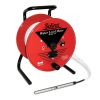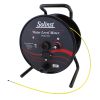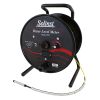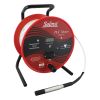Solinst Model 101B Water Level Meters
Features
- Very affordable, high quality Solinst product
- No buttons or controls to operate
- Rugged, corrosion-resistant components
- Free ground shipping
- Expedited repair and warranty service
- Lifetime technical support
- More
Basic Water Level Meter
The Solinst Model 101B Water Level Meter is designed to be an economical and basic, yet durable, instrument to measure groundwater levels. It is ideal for measuring depth to water in wells, boreholes, standpipes, and tanks. Also available from Solinst, are the Standard Model 101 Water Level Meters that feature a laser marked PVDF flat tape, and the Model 102 Coaxial Cable Water Level Meters. Both options allow shut-off and sensitivity adjustment.
Water Level Meter Operating Principles
The Model 101B Water Level Meter uses a solid stainless steel probe, connected to durable polyethylene flat tape. A standard 9 volt battery, housed inside the reel hub, powers the Water Level Meter. The electronics are coated for water resistance. When the probe enters water the electrical circuit is completed, sending a signal back to the reel where a light and clearly audible buzzer are activated. The water level is then determined by taking a reading directly from the tape at the top of the well casing or borehole.
Sturdy Reel and Handle
The Model 101B Water Level Meter has a sturdy frame and ergonomic handle for winding the tape. A brake is also included on the reel. The faceplate is easy to remove in order to access the 9 volt battery for replacement. For convenience, there is also a probe holder on the front of the faceplate.
Robust, Accurate Probe
The Model 101B P1 Probe is made from durable stainless steel. It is designed to reduce false signals in cascading water. The probe is extremely easy to replace.
Heat Embossed Polyethylene Flat Tape
The Model 101B Water Level Meter uses high quality polyethylene flat tape with accurate heat embossed markings every centimeter and meter. The 10mm (3/8") wide tape reels smoothly, remains flexible, hangs straight in the well and is available in 30m, 60m, and 100m lengths. Seven stranded stainless steel conductors resist corrosion, provide strength and are non-stretch. They make the tape very easy to repair and splice. The dog-bone design reduces adherence to wet surfaces.
In The News
Research in the Reserve: Promoting Interdisciplinary Conservation at the Great Bay National Estuarine Research Reserve
On an early winter day in 1973, a helicopter buzzed over Durham, New Hampshire, just a few miles from the Atlantic Ocean. One of the helicopter’s guests, oil magnate Aristotle Onassis, owner of Olympic Refining, looked east of town and saw what he hoped would become the world’s largest oil refinery. Instead, he saw the Great Bay; thousands of acres of green coastal forest, mud flats, salt marshes, and estuarine tidal waters stretching over the land toward New Hampshire's small Eastern coastline. Onassis likely also saw a group of Durham residents staked out on the bay’s coast, ready for him to pass overhead. While out of place in the natural setting, an obvious message was spelled out in red paper: “Not Here.
Read MoreFloating Global New Ideas: Buoy-Enabled Research at Florida Agricultural and Mechanical University’s School of the Environment
Florida Agricultural and Mechanical University (FAMU), based in Tallahassee, Florida, is the highest-rated public Historically Black College or University in the United States. FAMU’s School of the Environment (FAMU-SOE) offers BS and BA degrees in Environmental Studies, and BS, MS, and Ph.D. degrees in Environmental Science, with specialisms available in areas including Environmental Policy and Risk Management, Aquatic and Terrestrial Ecology, and Biomolecular Sciences. In 2021, FAMU-SOE deployed a NexSens CB-450 buoy in Apalachee Bay, a key oyster farming area around 30 miles south of Tallahassee. The buoy has quickly been incorporated into the curriculum, providing environmental insights for student research, the community, and beyond. Dr.
Read MoreMonitoring Habitat Suitability and Water Quality in Northwest Arkansas Springs
Northwest Arkansas has seen an economic, industrial, and population boom in recent years as a result of expanding businesses, which have created thousands of jobs in the region and the mass migration of employees and construction companies. However, with this growth has come rapid urbanization and the degradation of the natural landscape, specifically the freshwater springs that can be found throughout the region. These springs are critical habitat centers for native wildlife, home to threatened and endangered fish, and those that have yet to be listed. Zach Moran, Assistant Professor of Fisheries Science at Arkansas Technical University, is working to help monitor these habitats and provide key data that will hopefully inform future development in the region.
Read More



















